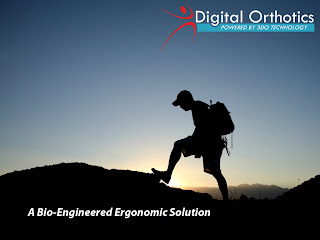The Biomechanics of Linear & Rotational Movement
Introduction
The biomechanics and ergonomics of movement is a difficult concept to understand. We have a very complex set of neurological interactions between the Cerebellum, Inner Ear, Visual Cortex, Extraparamidal Element of the Spinal Cord, compounded by Mass Loading of Load bearing joints, Phasic Firing of Extrinsic and Intrinsic muscles, all which work in a synchronous interaction with each other to keep us from falling forward.
The critical element of this chain of events is the anatomy and Tri Motion function of the foot, which allows us to move forward along with froward momentum created by gravity. The complexity of the foot gives it the unique ability to absorb impact loading (heel contact along with the knee), and within a precise millisecond, it changes into a Rigid Adapter through complex joint wedge interlocking between the rearfoot (Sub Talar Joint) and midfoot (Midtarsal Joints) to that of a stabilizer. In addition the 1st Ray (Navicular, medial cuniform, 1st Metatarsal and Hallux (big toe) needs to properly resist abnormal foot collapse (pronation) by plantarflexing during the midstance phase of the gait cycle. Wow... what a mouthful of activity.
If the foot can not properly absorb impact loading and properly transmit these forces properly, then these abnormal forces will transition up the leg effecting one or more load bearing joints which over time can create injury and disease such as degenerative osteoarthritis.
General Foot Types: There are many foot types, however these are the three basic foot types most commonly seen.
_________________________________________________________________________________
The Biomechanics of Linear Movement
As Biomechanical Specialists, we are concerned about the types of movements the athlete performs. Linear movement is quite different than Rotational Movement. Certain joints are affected by problems in linear movement, namely the rearfoot (Sub Talar), the midfoot (Midtarsal) and 1st Ray (medial forefoot column). Upper joint areas are also vunerable, namely the knee which is severely affected from abnormal foot collapse, (pronation) which disrupts the normal hinge function of the knee. The hip and spine are also affected by the same problem of pronation. In controlling linbear movement, proper rearfoot to midfoot alignment (neutral joint positioning) is critical.
Methods such as casting or foam boxes and even Laser imaging can cause a series of errors in making a corrective Bio Engineered Device. 3DO (3D Orthodynamics) is more accurate because it does not rely on the "Art Form" associated with casting and foam box impressions. This would also include Laser as well. If the technician or physician does not compute the proper deformity and replicate this in the casts, we are waisting our time in manufacturing, In addition, there are lab errors in the manufacturing process as well that add to the identified 27 error points associated with this Art Form.
3DO Imaging starts with a stable and reproducible stance position and then software is used to reposition the foot geometry through dynamic analysis of Mass Displacement, Motion Analysis, Pressure Analysis, Body Balance, Symmetry, Gait Analysis and 3D Geometry.
The data is then fed to manufacturing methods for custom manufacturing;
- CNC Milling
- Thermo-pressed Shell Manufacturing (best) which pre-stresses the plastic to take repetitive cyclic load conditions and not break down and loose correction.
Linear Movement Types
- Walking
"Its time to go for a walk"
- Hiking (Walking on variable terrain)
- Running (Movement with linear velocity)
The Biomechanics of Rotational Movement
Rotational Movement requires the foot to supinate and pronate as the body repositions in different movements. Goals of intervention are to allow the foot to have increased range of motion. We use more flexible stressed induced plastics that can take repetitive stress and not loose their geometric positioning.
Examples of Rotational Movement Types
- Tennis, Racket ball and Basketball
- Cleted Sports (Football, Soccor, Baseball)








